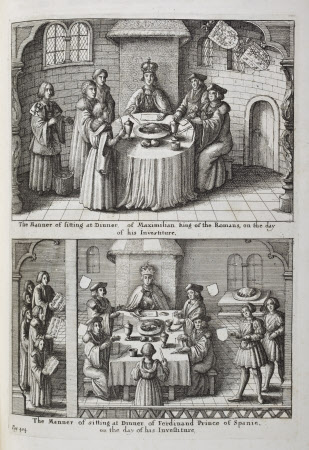The institution, laws & ceremonies of the most noble Order of the Garter. / Collected and digested into one body by Elias Ashmole of the Middle-Temple Esq; Windesor Herald at Arms. A work furnished with variety of matter, relating to honor and noblesse.
Elias Ashmole (1617-1692)
Category
Books
Date
1672
Materials
Book with brown morocco over boards for binding.
Place of origin
London
Order this imageCollection
Anglesey Abbey, Cambridgeshire
NT 3026656
Summary
Elias Ashmole, The Institution of the Order of the Garter, London: printed by J. Macock for Nathanael Brooke, 1672. Binding: Nineteenth-century full brown morocco over boards; gilt fillets and tools to form a border and central panel; inner border elaborately gilt; spine gilt with title ‘Ashmole’s Order of the Garter’; six raised bands; double gilt fillets on board edges; gilt turn-ins; gilt paper edges; marbled endpapers; binder’s stamp on flyleaf and binding: Bound by F. Bedford [i.e. Francis Bedford, 1799-1883].
Full description
Shortly after they returned to England in 1912, the future Lord Fairhaven’s parents purchased a large modern house at Englefield Green, a handsome but even then rather suburbanised village on the edge of Windsor Great Park. It was the beginning of a lifelong fascination, and the impetus for the creation of what was about to become the largest collection of works of art about Windsor to be found anywhere outside the Royal Collection. The fact that the then Huttleston Broughton was stationed in the town during his time in the life guards through the First World War can only have heightened the attraction. The Windsor collections seems originally to have been kept in the Englefield Green house, which was retained until his mother’s death in 1939, apparently only later being shifted to Anglesey Abbey. Sometimes criticised for his failure to sponsor proper catalogues of his collections – the mark of a really serious connoisseur – Fairhaven was sufficiently enthused by Windsor to commission a description of the Windsor pictures, prints, drawings and books in his collection in 1949, written by the popular art historian Cyril Bunt. Elias Ashmole’s ‘Institution of the Order of the Garter was almost inevitably a book which captured Lord Fairhaven’s imagination. His pristine copy, in a smart nineteenth-century binding by Francis Bedford (1799-1883), with gilded edges, the pages crisp and thoroughly washed, is typical of many of the earlier books in his library. Heavily done over, and effectively stripped of much of its own history, it is undeniably slightly unappealing to current tastes. On opening it however, the splendid engravings by Wenceslaus Hollar (1607-77) are revealed. Born in Prague, Hollar first arrived in London in 1936 in the retinue of Thomas Howard, 2nd Earl of Arundel, originally to make copies of paintings and drawings in the great collection at Arundel House. In addition to his numerous topographical and fine art engravings, Hollar established a considerable reputation as a book illustrator, and was involved in several important antiquarian projects, notably William Dugdale’s ‘Monasticon Anglicanum’ (1655) and his marvellous ‘History of ST Paul’s Cathedral, published, in the nick of time, in 1658 (the old cathedral was destroyed in the 1666 fire of London). Interestingly enough, the Fairhaven collection also includes three pen-and-pencil drawings of Windsor by Hollar, as well as three contemporary oil paintings of the castle by Hendrick Danckerts (1630-78), Jan Wijck (1640-1702), and Gerard Edema (1652-1700). There is, however, a further connection; both Ashmole’s book and, especially, this plate have a special resonance at Anglesey Abbey, which also houses the Garter of the Emperor Maximilian (1459-1519). The emperor was created a Stranger Knight, a member of the Order of the Garter, by Henry VII in 1489, and Garter insignia were delivered to him in 1490, and again in 1503. It was conventional for the insignia to be returned to the sovereign on the death of each knight, but at least one of Maximilian’s became an heirloom of the Hungarian Counts Festetics, remaining in their possession into the twentieth century. It is the earliest surviving Garter, the next earliest being that sent by Edward VI to Frederick II of Denmark (1534-88), which is now in the Danish royal collection at the Rosenborg Castle in Copenhagen. Text adapted from ‘Treasures from Lord Fairhaven’s Library at Anglesey Abbey’, National Trust, 2013.
Bibliographic description
[12], 130, 135-136, 149-719, [105] p., [34] leaves of plates (15 folded) : coats of arms, ill., port. ; fol. Large paper. Provenance: Nineteenth-century circular armorial bookplate: Leybourne Grange. Twentieth-century armorial bookplate (large variant), signed Badeley 1930: Urban Huttleston Rogers Lord Fairhaven [i.e.: Urban Huttleston Broughton (1896-1966)]. Pencil price note on flyleaf: £8-10-0. Binding: Nineteenth-century full brown morocco over boards; gilt fillets and tools to form a border and central panel; inner border elaborately gilt; spine gilt with title ‘Ashmole’s Order of the Garter’; six raised bands; double gilt fillets on board edges; gilt turn-ins; gilt paper edges; marbled endpapers; binder’s stamp on flyleaf and binding: Bound by F. Bedford.
Provenance
In the library of Sir Joseph Hawley, of Leybourne Grange, West Malling, Kent, by c. 1875 (see: 'Catalogue of the Library at Leybourne Grange' (London: Ellis and White, [c. 1875] and Sotheby's, 1906)); purchased by Huttleston Rogers Broughton, 1st Lord Fairhaven (1896-1966) from Brown's Antiquarian Bookshop, Eton, 17 September 1934, for £8 10s and then bequeathed by him to the National Trust with the house and the rest of the contents in 1966.
Makers and roles
Elias Ashmole (1617-1692) Wenceslaus Hollar (Prague 1607 - London 1677), engraver (printmaker) William Sherwin (Wellington 1645 - 1711), engraver (printmaker)
References
Mark Purcell, William Hale and David Person, Treasures from Lord Fairhaven’s Library at Anglesey Abbey, Swindon: National Trust; London: Scala Arts & Heritage Publishers, 2013., pp. 54-5
